As anyone that has ever driven through West Virginia knows this state is one of the most mountainous states in the country. It’s the only state that is completely within the borders of the Appalachian Mountains and it intersects with the Blue Ridge Mountains too. West Virginia is known for thick dense forests, mountains, and enormous canyons cut through the mountains by water which they call “gaps”.
The rugged terrain of this state attracts wildlife who prefer mountain habitats including snakes that like to be away from people as much as possible. There are twenty native snake types in West Virginia. Only two of them are venomous, but always remember that any snake will strike out or bite if provoked.

11 Snakes In West Virginia
West Virginia may not have a huge variety of snakes but this state does have some very colorful snakes. Some of the most common snakes that you will find in West Virginia are:
Smooth Earth Snake
These tiny snakes prefer wooded habitats so they love the mountain forests and wooded areas of West Virginia. Smooth earth snakes can be just seven inches long and are almost never more than a foot long. You may not even see them unless it’s after a rainstorm because they tend to come out more after the rain. They have a gray-green or tan coloring that helps them blend into the forest foliage and rocks that they like to hide under.

These tiny, Smooth Earth
snakes
prefer wooded habitats so they love the mountain forests and wooded areas of West Virginia.
©Matt Jeppson/Shutterstock.com
Northern Red-Bellied Snake
Northern red-bellied snakes are another small type of snake that are typically just about a foot long. But, the vivid red bellies on these snakes make them stand out. Their top sides are usually dull colored brown but they have very bright red bellies. Northern red-bellied snakes like woodland areas but they also frequently are found in suburban or rural areas in gardens and agricultural fields.
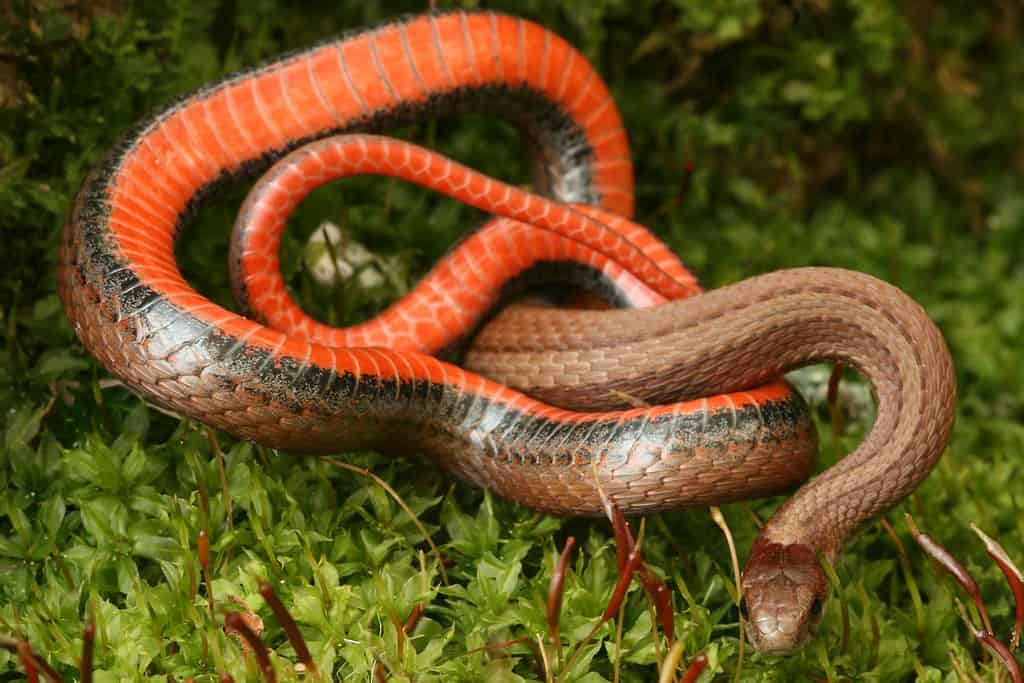
Red-bellied snakes are cousins to Dekay’s brownsnakes.
©Kevin Collison/Shutterstock.com
Smooth Green Snake
You definitely won’t miss a smooth green snake, although they would probably prefer it if you did. These little snakes are less than two feet long. They have a solid bright green color on top, and they have yellow or cream bellies. While it’s never a good idea to handle wild snakes these little snakes are very non-aggressive and non-threatening and they won’t bite or become aggressive as long as you are gentle with them. Instead of biting these snakes will emit a very bad-smelling musk if they feel cornered. So beware of handling a smooth green snake if you don’t want to get some very bad-smelling funk on you.
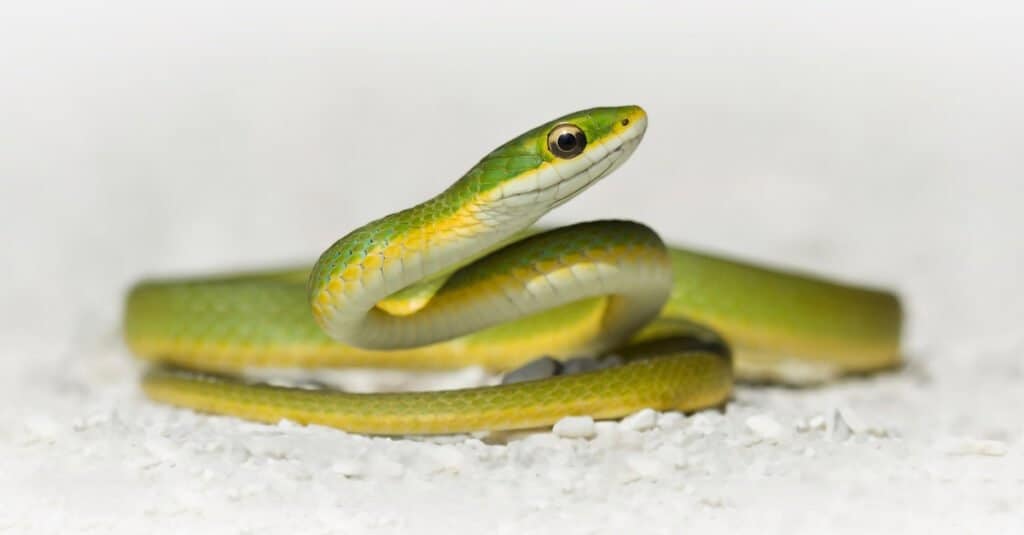
Instead of biting the Smooth Green Snake will emit a very bad-smelling musk if they feel cornered.
©Kristian Bell/Shutterstock.com
Northern Pine Snake
As the name suggests northern pine snakes prefer to live in pine forests. The sheer size of these snakes can be intimidating and a bit scary but they are not venomous. They have very large thick bodies and can be 90 inches long. Typically they are white or gray with dark gray or dark green markings. Their unusual colors help them blend into the pine forest foliage and rocks. They do sometimes make a fake rattling sound by moving their tail very quickly to warn off predators. But these snakes are not venomous and won’t hurt you so don’t be frightened of them.
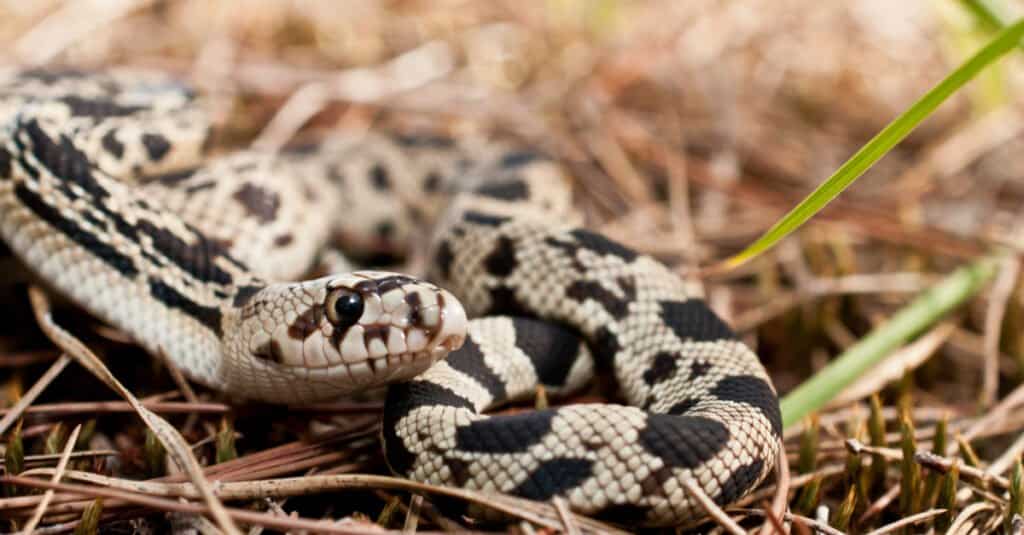
The sheer size of the Northern Pine Snake can be intimidating and a bit scary but they are not venomous.
©Jay Ondreicka/Shutterstock.com
Common Garter Snake
Like most other states West Virginia has a large population of common garter snakes. Garter snakes are usually two to three feet long, although they can be up to four feet long. They have varied colorations that are designed to help them blend into whatever habitat they are living in but always have two thin yellow or cream-colored stripes running down the length of their bodies. Common garter snakes are not aggressive at all and won’t hurt you even if you surprise one.
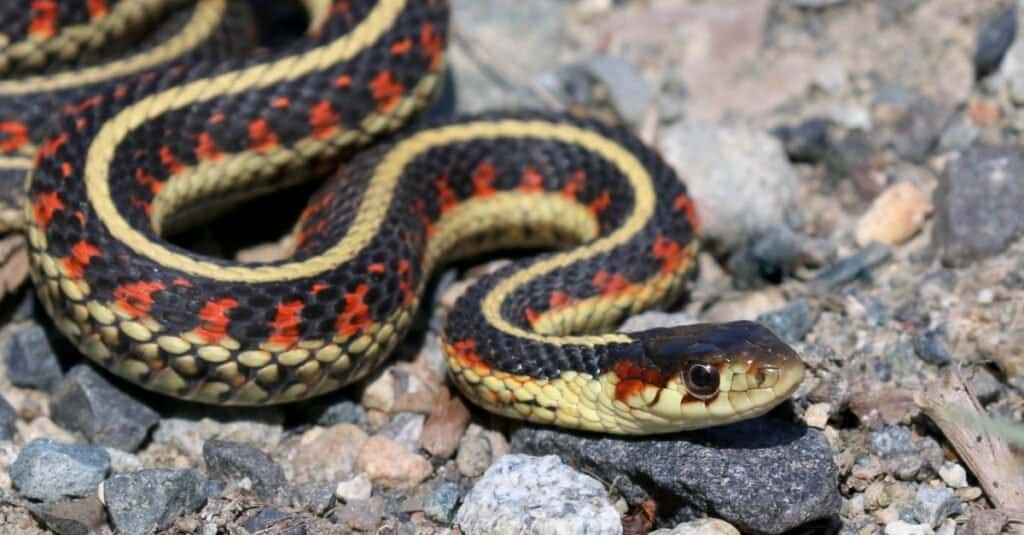
Like most other states West Virginia has a large population of common garter snakes.
©iStock.com/randimal
Northern Black Racer Snake
Northern black racer snakes are known for their speed. When these snakes are really motivated they can travel at speeds up to four miles per hour. They can’t sustain that kind of speed for long but it makes them able to get out of dangerous situations very quickly. Northern black racers are very long and thin so they can move quickly. If you surprise a black racer snake they aren’t going to wait around to find out if you’re a threat. They will just get out of there as fast as they can.
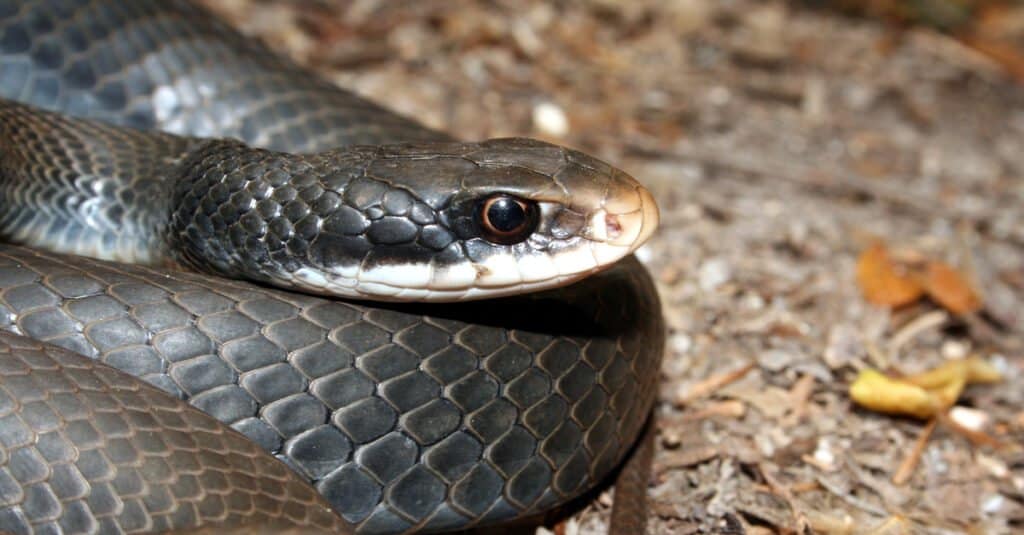
When the Black Racers are really motivated they can travel at speeds up to four miles per hour.
©Psychotic Nature/Shutterstock.com
Common Ribbon Snake
Common ribbon snakes are semi-aquatic, which means that they do spend some time hunting on land. They prefer to live in and near lakes and ponds, like the mountain-fed lakes in West Virginia. Ribbon snakes can be anywhere from one to four feet long. They are very thin and look like long curling pieces of ribbon, which is where their name comes from.
Most ribbon snakes are dark brown with three lighter stripes running down their sides. Their coloration helps them blend into the bottom of the lakes and rivers they like to be in so that they can hunt. A ribbon snake won’t flee if you come across it but it may try to flatten itself into the dirt and debris on the floor of the lake or river. It also may try to hide in the vegetation around the body of water.
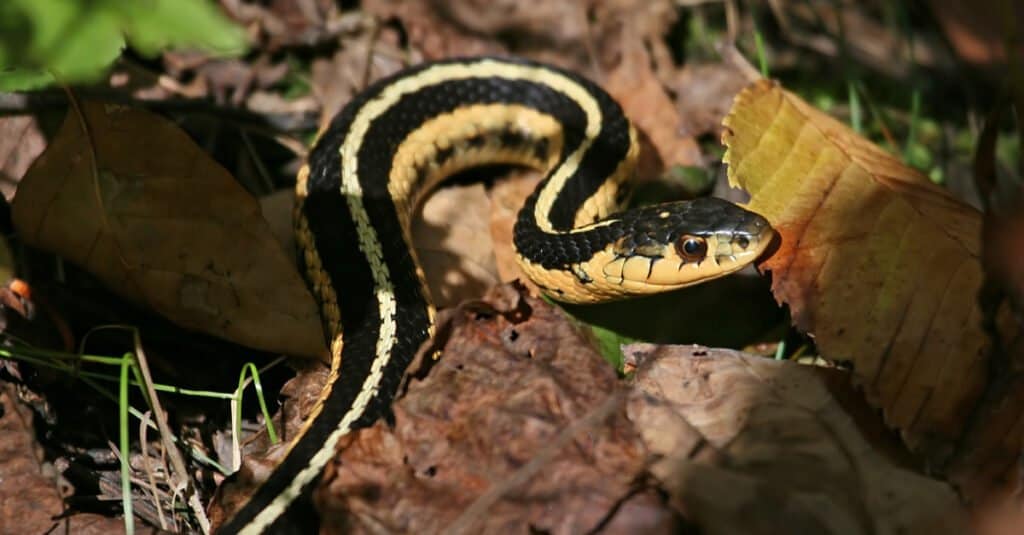
Common ribbon snakes prefer to live in and near lakes and ponds, like the mountain-fed lakes in West Virginia.
©John Czenke/Shutterstock.com
Water Snakes In West Virginia
West Virginia is known for the stunning mountain views that it has, but it does have a lot of natural water canyons, mountain rivers and streams, and lakes. That’s where you will find these three water snakes in West Virginia:
Northern Water Snake
Northern water snakes are sometimes mistaken for cottonmouth snakes. Both are dark brown and kind of dull colored to help them blend into the water of the lakes where they live. But, the northern water snake doesn’t have a white mouth like a cottonmouth. The northern water snake also is not venomous, so you don’t have to worry about it biting you. There are no venomous water snakes in West Virginia so if you see a snake in the water or near the water you don’t have to worry. It’s not venomous.
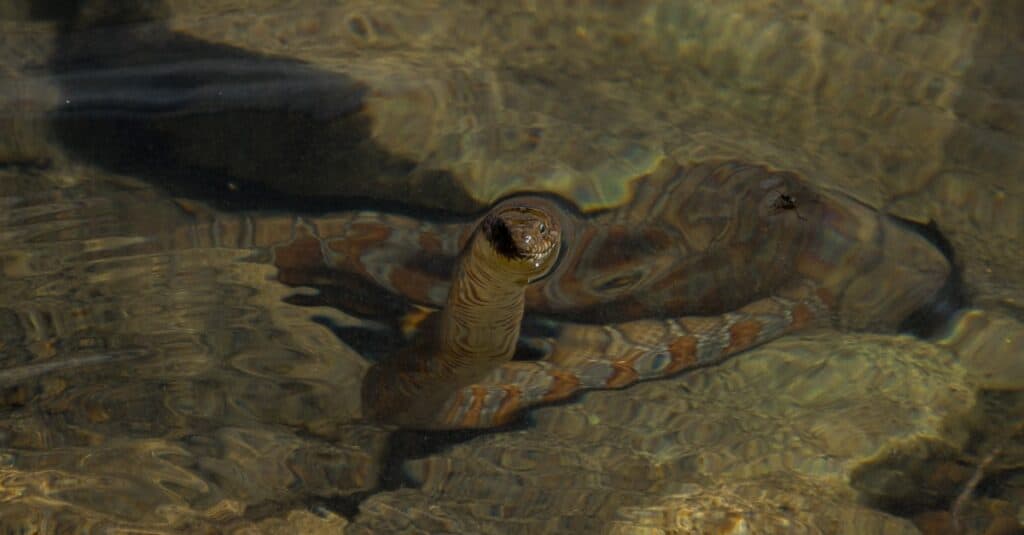
Northern water snakes are sometimes mistaken for cottonmouth snakes.
©iStock.com/manuellacoste
Queen Snake
Queen snakes are about two feet long. They like to stay in fast-moving water so they primarily live in mountain streams and rivers that have swift water flows. You will be able to tell queen snakes by their short length and by their stripes. Even though they are dull colored brown or tan on top they have two long stripes running down the entire length of their cream or yellow colored bellies. They are the only snakes that long stripes on their bellies.

Queen snakes like to stay in fast-moving water so they primarily live in mountain streams and rivers that have swift water flows.
©Jason Patrick Ross/Shutterstock.com
Venomous Snakes In West Virginia
There are only two types of venomous snakes that you have to worry about when you’re in West Virginia. Just remember that if you do come across a venomous snake the best thing to do is stop moving, wait a minute, and back up slowly. The snake will usually leave rather than strike out at you. The venomous snakes in West Virginia are:
Northern Copperhead Snake
In West Virginia, the northern copperhead snakes tend to stay in the deep forests where there is a lot of leaf litter for them to hide in. They like to keep themselves hidden by leaves and other vegetation. Typically a northern copperhead is about three feet long and will have brown, tan and orange-red colorations. In West Virginia, they usually have dark brown and tan colors to help them hide in the leaves on the forest floor or hide in old tree limbs and stumps.

In West Virginia, the northern copperhead snakes tend to stay in the deep forests where there is a lot of leaf litter for them to hide in.
©iStock.com/David Kenny
If you are hiking or walking in the woods and you surprise a northern copperhead it could strike you out of fear. But even though this snake is venomous the toxin in the venom is rarely fatal for humans. Get medical help as fast as possible and you should be ok.
Timber Rattlesnake
The timber rattlesnake is another story. The venom that this rattlesnake has is extremely potent. If you are even bitten by a timber rattlesnake getting help as fast as possible is absolutely essential. Timber rattlesnakes can be almost 60 inches long and they love rocky areas and woodland areas. If you frequently hike in the mountains always walk carefully and scan the area in front of you and next to you for movement before you take a step. Timber rattlesnakes don’t often bite unprovoked, so you should have time to slowly back off before a timber rattlesnake moves to strike.
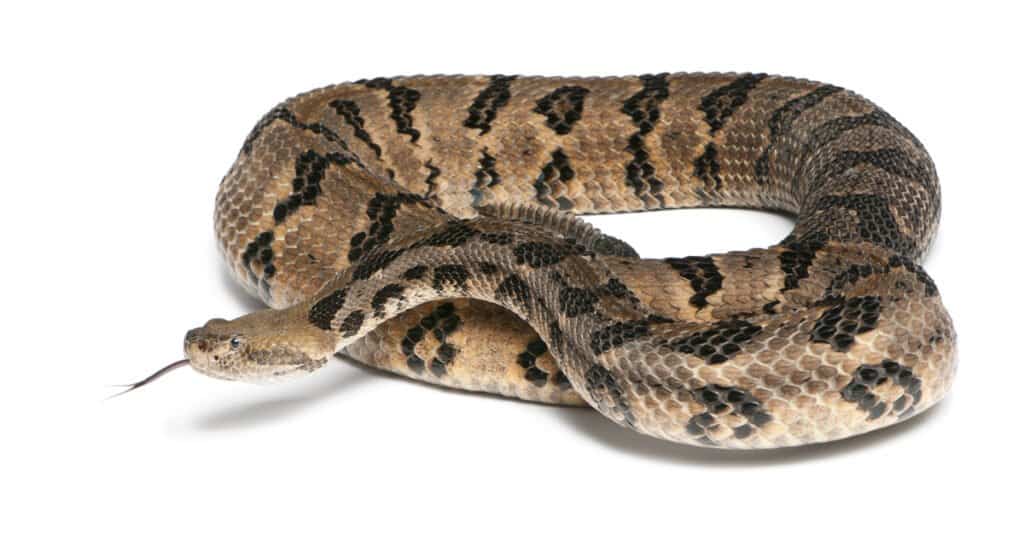
Timber rattlesnakes can be almost 60 inches long and they love rocky areas and woodland areas.
©Eric Isselee/Shutterstock.com
Summary of 11 Snakes In West Virginia
West Virginia is a hiker’s paradise with so many stunning mountain trails to hike. And the residents who live there know that their state is one of the most beautiful in the country. When you’re in West Virginia this is a complete list of the snakes you might see there:
| Number | Snake | Venomous? |
|---|---|---|
| 1 | Smooth Earth Snake | No |
| 2 | Northern Red-Bellied Snake | No |
| 3 | Smooth Green Snake | No |
| 4 | Northern Pine Snake | No |
| 5 | Common Garter Snake | No |
| 6 | Northern Black Racer Snake | No |
| 7 | Common Ribbon Snake | No |
| 8 | Northern Water Snake | No |
| 9 | Queen Snake | No |
| 10 | Northern Copperhead Snake | Yes |
| 11 | Timber Rattlesnake | Yes |
The photo featured at the top of this post is © iStock.com/David Kenny
Discover the "Monster" Snake 5X Bigger than an Anaconda
Every day A-Z Animals sends out some of the most incredible facts in the world from our free newsletter. Want to discover the 10 most beautiful snakes in the world, a "snake island" where you're never more than 3 feet from danger, or a "monster" snake 5X larger than an anaconda? Then sign up right now and you'll start receiving our daily newsletter absolutely free.
FAQs (Frequently Asked Questions)
What makes the state of West Virginia unique?
West Virginia is the only state that is completely within the borders of the Appalachian Mountains and it intersects with the Blue Ridge Mountains too. West Virginia is known for thick dense forests, mountains, and enormous canyons cut through the mountains by water which they call “gaps”.
What types of aquatic snakes are in West Virginia?
West Virginia is home to the Northern Water Snake, Queen Snake, and Common Ribbon Snake. All are aquatic or semiaquatic.
Thank you for reading! Have some feedback for us? Contact the AZ Animals editorial team.






